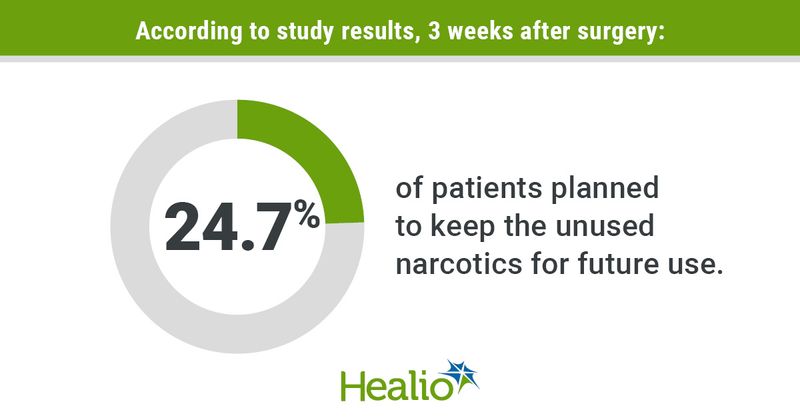Study: Most prescribed opioids remain unused after arthroscopic surgery
Key takeaways:
- Researchers found 71% of all opioids consumed in the study period came in the first 3 postoperative days.
- By day 4, 63% of patients had discontinued their opioid use.
WASHINGTON — Most prescribed opioids remain unused after elective outpatient arthroscopic procedures, and one-quarter of patients plan to keep remaining medication for future use, according to results of a study presented here.
“The overall message remains the same and the majority of opioids prescribed following these procedures went unused, leaving an average of 11 5-mg oxycodone pills remaining after every case,” William Johns, MD, said during a presentation at the American Orthopaedic Society for Sports Medicine Annual Meeting.

In the prospective observational study, Johns and colleagues enrolled 185 patients who were aged 15 to 40 years. Patients with an active workers compensation case or a substantial past or recent usage of opioid use were excluded from the study.

Overall, 85 patients had elective ACL reconstruction; 26 patients underwent arthroscopic hip labral repair; 37 patients had arthroscopic shoulder labral repair; 23 patients underwent meniscectomy and 14 patients had meniscal repair surgery. The patients had been prescribed 5 mg hydrocodone-acetaminophen or 5 mg oxycodone-acetaminophen according to surgeon preferences. For 2 weeks postoperatively, patients recorded daily opioid usage. Additionally, patients completed a survey on postoperative day 21 about continued opioid use and plans for disposal of unused opioids.
Researchers found 71% of all opioids that were consumed in the study period came in the first 3 postoperative days. By day 4, 63% of patients had discontinued their opioid use.
When researchers compared usage to the initial prescription, they found 39% of the prescription was utilized, on average, for all procedures.
“Looking at this in a different way, that means over 60% went unused,” Johns said.
Researchers found the utilization rate of the opioids in the first 14 postoperative days was 40.4% for ACL reconstruction, 36.5% for hip arthroscopy, 40.7% for shoulder arthroscopy, 37.4% for meniscectomy and 34.6% for meniscal repair. The mean morphine milliequivalents consumption was the greatest on the first postoperative day for all procedures, with 6.6% of patients reporting continued opioid use during the third postoperative week.
At 3-week follow-up, 113 patients of the available 141 patients reported having remaining opioids. Of these patients, 24.7% of patients reported their intention to keep the unused narcotics for future use.
Johns said younger patients of high school and college age consumed significantly fewer opioids. Additionally, a higher proportion of younger patients expressed their intent to dispose of unused opioids in a more responsible way.

